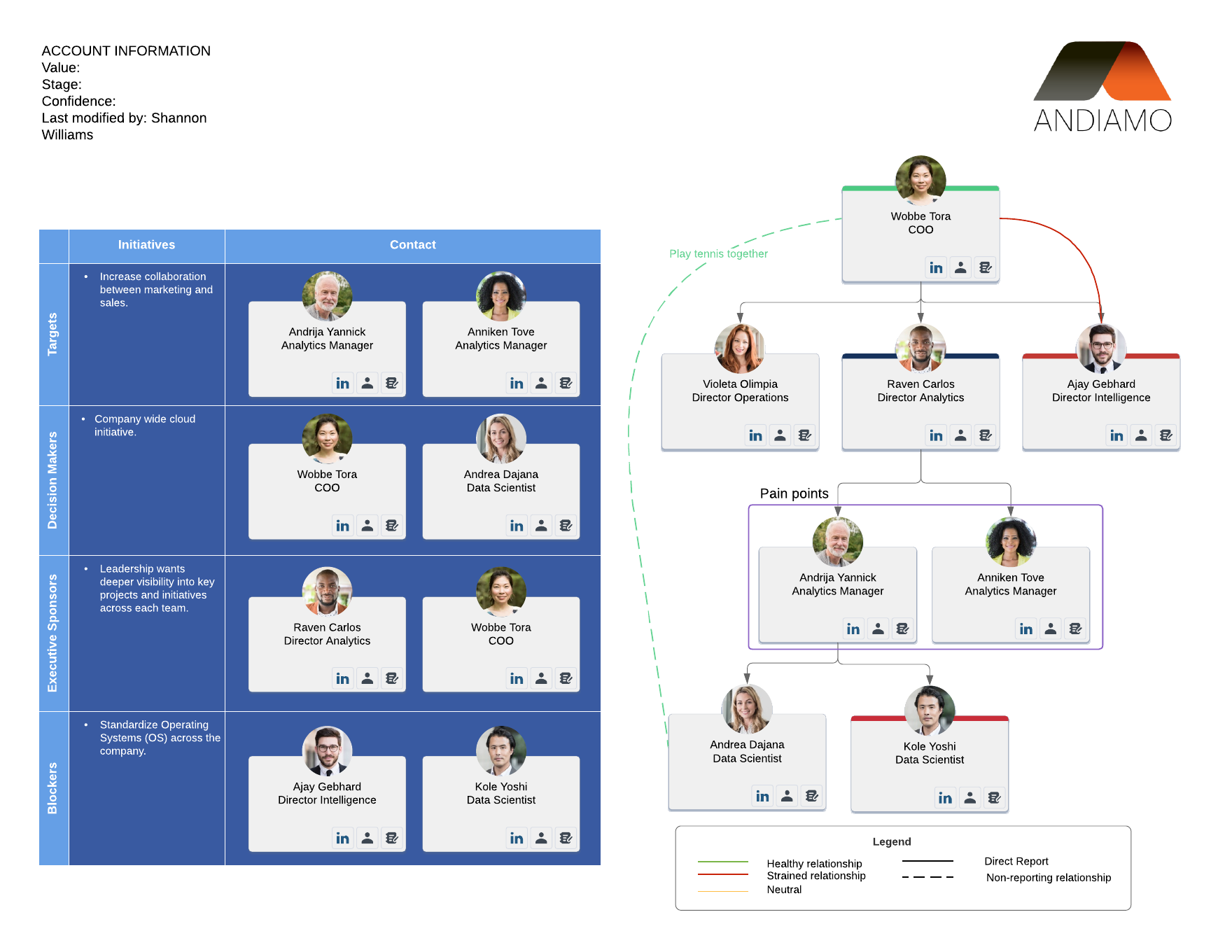Do you struggle to connect with the C-suite? The truth is many sales reps do. From rookies to seasoned sales leadership, nailing C-level communications is a challenge. But failing to reach your C-level prospects (literally or figuratively) can cost valuable sales.
Whether you’re cold calling or attending a coveted pitch meeting, learning how to talk to C-level executives is crucial. Use these tips to talk to senior leadership and nail the sale.
Build wide support
It may sound counterintuitive, but if you want to sell to the executives, don’t start at the C-suite first. Instead, work your way up the chain of decision-makers to get widespread buy-in.
While the CEO might have the final say, most CEOs don’t make decisions unilaterally. So they are unlikely to give you their stamp of approval without the recommendation and support of lower-level stakeholders.
In other words, C-level executives want to know their tea ms are on board with a vendor or solution before they invest in it.
Which makes sense. Why would a leader adopt a product or invest in a solution that no one wants?
That’s a recipe for failed buy-in and sunk costs. And they don’t have time for that.
To ensure a greater chance of success (and to avoid wasting precious time), get support from other key stakeholders who may not be in executive leadership but can influence the conversation.
Identify the right stakeholders
Similarly, the CEO is not always the person making the decision on your proposal. (Or at least not the only one.) Whether it’s another C-level executive or senior leadership in another department, do your research to identify the stakeholders who are most relevant to the sale.
Otherwise, you will waste your time and, more importantly, their time.
Identify the appropriate stakeholders may require some detective work on your end. Check out a few ways to get started and to narrow down your potential targets.
Use LinkedIn to find a common connection and ask them to make an introduction with the right stakeholders. (This is the ideal because it gets you to the right person with the added social proof of a personal referral.)
Map the organization to discover the institutional structure and relationships between people, departments, and roles. An account map can help you visualize the leadership structure and find the most relevant stakeholders. (Use Lucidchart to create the map from scratch or import data directly from Salesforce.)

Ask. Sometimes the quickest way to connect with the right decision-makers is to ask “Who is the right person to talk about XYZ?” Typically you should call someone in a senior leadership position who you’re confident would know the right stakeholders even if they themselves aren’t involved.
With a little research and strategic communications, you can identify the decision-makers and pitch to the right people every time.
Come prepared
One of the biggest mistakes sales reps make when approaching a sales conversation with a C-level executive is failing to properly prepare.
Once you know who you will be meeting with or calling, do your research. Learn everything you can about the person as well as the business so you can speak directly to their pain points and communicate the specific value your solutions offer.
Failing to do so is disrespectful of their time and won’t earn you any favor.
Before your sales call, you should understand:
- Who the competition is
- What relevant industry leaders are doing
- What trends are happening in the regional market
- How the prospect’s organization operates
While it’s okay to ask clarifying questions in the meeting, you should come armed with most of the answers already. Executives want to know what new insights and opportunities you see. And you can’t deliver that value without doing the heavy lifting ahead of time.
Draft a goal-oriented agenda
Failed C-level conversations often occur because the sales rep either over-prepared or under-prepared their agenda.
An over-prepared agenda is jam-packed with points and doesn’t provide the flexibility to address other needs or concerns that may arise organically during the conversation. A rigid agenda like this can make your conversation stiff and unnatural, making it difficult to build rapport.
In contrast, an under-prepared agenda lacks a clear plan and focus. You might miss key points and waste time as you gather your thoughts and try to lead the conversation off the cuff. When you’re talking to the C-suite, “winging it” is a surefire way to failure.
A more effective approach is a goal-oriented agenda. Instead of focusing on general talking points, craft your agenda with a goal in mind so that each point is strategically placed to guide the conversation and the meeting towards your desired “destination.” This will keep your meeting on track while allowing for dialogue and questions.
Listen to your prospect
Executives are accustomed to being listened to and will bristle at traditional, aggressive sales tactics that tend to steamroll the conversation. (And let’s face it, most people—C-level or otherwise—don’t like to be talked at.)
If you want to be taken seriously (and not annoy your prospect), actively listen to them.
Besides coming across as rude and damaging your rapport, failing to listen can rob you of valuable opportunities to learn and address your prospect’s actual concerns.
Sales conversations should be dialogues, not monologues. While you are presenting a pitch, you should be adjusting it and delivering it based on the context of your conversation. This method will make your meeting more productive and help you build a relationship of trust with your client.
Lead with insights
Selling to the C-suite is different from selling to lower-level stakeholders. Where traditionally, sales reps are trained and encouraged to ask a series of discovery questions to qualify their leads, executives don’t have the time or patience to be interrogated. (And trust us, that’s exactly how it feels to them.)
In fact, Gong.io recently published data showing how discovery questioning can actually hurt your chances of closing the deal when selling to executive-level leads.
After analyzing recorded sales meetings from over 39,000 deals, Gong.io found that in successful sales meetings, reps asked an average of just four questions.
These findings highlight an important principle of C-level selling: lead with insights, not questions.
Your job is to deliver value to executives, not have them educate you on their business. That is why preparation and research are so important. By the time you sit down with the CEO, you should know their business and pain points and deliver insights into the opportunities, risks (and solutions) they might not have considered.
Using Lucidchart to convert the C-suite
Still not sure how to talk to C-level executives? Keep in mind that executives are short on time and put a premium on people who can deliver value.
Use visuals to support your sales process from prep to pitch. Visuals help sales reps quickly show busy execs the big picture and hone in on the most important points and insights.
Lucidchart can help. Lucidchart is a cloud-based diagramming platform that helps sales teams engage their leads and communicate value more powerfully. Use Lucidchart to create:
- Account maps to identify key decision makers and affected stakeholders
- Process maps outlining the prospect’s current state and future opportunities
- Conversation trees to plan productive meetings and agendas
- Data visualizations to demonstrate ROI and make connections clear
C-level communication can be difficult to master, but the effort is worth it. By taking the time to understand this unique buyer and address their key concerns, you’ll be prepared to land some of the most lucrative deals in the business.

See for yourself how Lucidchart can help you identify the right stakeholders and speak to their needs.
Sign up nowAbout Lucidchart
Lucidchart, a cloud-based intelligent diagramming application, is a core component of Lucid Software's Visual Collaboration Suite. This intuitive, cloud-based solution empowers teams to collaborate in real-time to build flowcharts, mockups, UML diagrams, customer journey maps, and more. Lucidchart propels teams forward to build the future faster. Lucid is proud to serve top businesses around the world, including customers such as Google, GE, and NBC Universal, and 99% of the Fortune 500. Lucid partners with industry leaders, including Google, Atlassian, and Microsoft. Since its founding, Lucid has received numerous awards for its products, business, and workplace culture. For more information, visit lucidchart.com.
Related articles
Announcing Lucidchart for Sales
We're excited to announce Lucidchart for Sales - new resources and templates to help teams use Lucidchart to accelerate the sales process.
Building credibility to close more sales
According to a 2017 report, trust is the most important factor in closing a deal. So if you want to learn how to close bigger deals faster, check out our suggestions on building a trusting relationship with your prospects.

